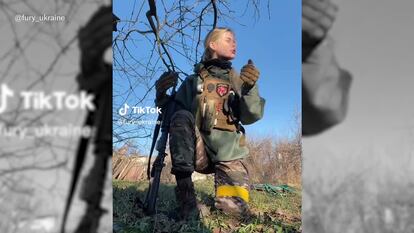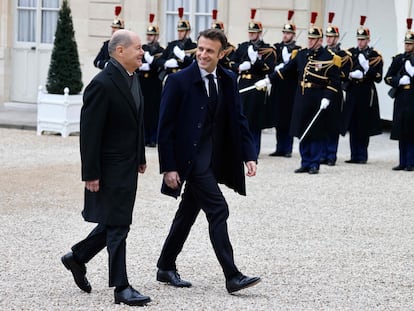Ukraine launches TikTok offensive: ‘It makes the truth more attractive’
The social media platform features videos of Ukrainian soldiers fighting at the front, shooting to electronic music and even taking part in dance challenges
The war in Ukraine is the first to be broadcast daily from the cellphones of the soldiers at the front. Since the beginning of the Russian invasion, Ukrainian soldiers have been using TikTok en masse to share their experiences in the war, the camaraderie among their ranks, and also to take part in TikTok trends, such as “Wednesday Addams Dance” (inspired by the character in the Netflix series Wednesday). Hundreds of soldiers have shared videos of themselves performing the routine among ruins, in the trenches and camouflaged in the forests of the eastern Donbas region.
In the TikTok accounts of Ukrainian soldiers, fun, light-hearted videos are mixed with gut-wrenching accounts of the war. In one video, a soldier who goes by the name of Gadamchiii (with 5,400 followers) shares a video from a trench allegedly in Bakhmut, the hottest spot on the front lines of the war. The footage shows him ducking as enemy shots fly overhead.
Another video that appears via TikTok’s search engine is from Slavko5904 (21,500 followers), a Ukrainian officer from a unit that operates a multi-launch Grad missile. In the video, the platoon fires the projectiles while dancing to electronic music.
@trump_r Ми знаходимо час для позитиву🫡🇺🇦 хто з нами то з вас лайк🫡🇺🇦Слава Україні 🇺🇦🇺🇦🇺🇦#soldier #wednesday #ukrainewar #army #ukraine #зсу #armylife #ukraine🇺🇦 #donbass #fakesituation #danse
♬ original sound - heyy
In the spring of 2022, Military Review, the leading magazine of the United States military, published a study on social media postings by Ukrainian troops during the first months of the war, including the use of “tactical TikTok.” According to the report’s authors, Colonel Theodor W. Kleisner and military analyst Trevor Garmey, the use of social media is permitted by the Ukrainian General Staff as its benefits outweigh the risk of the enemy obtaining information about Ukraine’s positions. These benefits include raising troop and civilian morale, and creating a positive and heroic image of Ukraine’s armed forces. Ukraine is heavily dependent on support from its allies, and the battle to win over public opinion may detemine the level of aid it receives from these governments.
“These messages make a young audience aware of our struggles,” Mikola Timkov, captain of the 3rd Brigade and its head of communications, told EL PAÍS last week. But it does come with risks, Timkov conceded. While the 3rd Brigade does not prohibit the use of TikTok, they prefer Facebook. Timkov’s main fear is that Russian troops will be able to identify their positions thanks to a TikTok video, especially if it is posted without a precautionary time interval to ensure that tanks are in a new location by the time the video is public. Viktor Tregubov, a captain in the Ukrainian Armed Forces and an expert in communication, agrees that Facebook is the official choice, explaining that there is concern over the fact that TikTok is owned by the Chinese company ByteDance. In practice, says Tregubov, each commander decides the rules, although few restrict the use of TikTok.
According to the Military Review report, another radical difference with the war in Ukraine – at least compared to US-led conflicts – is that journalists have very limited access to the front. This is a decision that has been made by both the Russian and Ukrainian armed forces. As a result, most testimonies of life at the front lines are told by Ukrainian fighters on their cellphones. “By letting its soldiers and the power of imagery tell the story, Ukraine has ensured a more authentic record of its resistance,” the article states.
Iuliia Mendel, former spokesperson for President Volodymyr Zelenskiy, believes that one advantage of TikTok compared to traditional media, “is that it makes the truth more attractive.” She explains: “Fake news spread more easily and the testimonials on TikTok make the truth of what is happening more attractive.” But she also notes that fake accounts on TikTok spread minisformation, and points out cases of Russians posing as Ukrainian soldiers to hurt their image. Another risk, says Mendel, “is that it can give the impression that war is fun, but it is not, as those who are there and journalists well know.”
“Totally spontaneous”
In the Military Review study, Kleisner and Garmey assume that the use of social media by Ukrainian troops is part of an information operation led by the General Staff, But Tregubov says that it is a “totally spontaneous” phenomenon. “They are young, they follow the current trends, they are under a lot of stress and it is a way to relax,” he says. “Before, in other wars, soldiers took photos of themselves, now they post on TikTok because that’s what is trending now.” Mendel also points out that the vast majority of the troops are not professional soldiers. “A year ago, thousands of them were civilians who also used social networks to talk about their lives,” she explains.
The Military Review report also assumed that the General Staff passed down rules on social media postings to units on the ground. Tregubov says that at the beginning of the war protocols were drawn up “because there were some problems,” but now there are no active manuals: the soldiers know what they can and cannot share.
But the risk still remains high. A platoon commander, who goes by the code name Kharhujc, posts daily TikTok videos from Bakhmut. If any building appears in the footage, Russian Twitter and Telegram accounts rush to try to identify his location and share the information on social media.
In the Miltary Review article, Kleisner and Garmey say that there are red lines that Ukrainian soldiers do not cross when it comes to TikTok content. These include videos of possible mistreatment of Russian prisoners and unconventional combat tactics that might ”inspire conflicted emotions from viewers in NATO units.” The study also points out that the videos rarely show images of Ukrainian casaulties, although testimonies of wounded Ukrainian soldiers have begun to appear due to the battle of Bakhmut.
It’s noteworthy that while Ukrainian soldiers are very active on TikTok, Russian troops are not. There are very few videos of Russian soldiers sharing their war experiences on the Chinese-owned app. This may be because they have lower morale, or because being a member of the invading force is a less appealing role than being a civilian who has only taken up arms to defend his or her country.
But Tregubov believes there is another reason: “There are also young people among the Russian fighters. If they are not on TikTok it is because they are strictly prohibited by their superiors, to avoid providing any information.” There is one exception, the Chechen units of warlord Ramzan Kadyrov, who have more autonomy than the Russian General Staff and periodically use social media as a propaganda weapon to bolster their image of tough and ruthless warriors.
Sign up for our weekly newsletter to get more English-language news coverage from EL PAÍS USA Edition
Tu suscripción se está usando en otro dispositivo
¿Quieres añadir otro usuario a tu suscripción?
Si continúas leyendo en este dispositivo, no se podrá leer en el otro.
FlechaTu suscripción se está usando en otro dispositivo y solo puedes acceder a EL PAÍS desde un dispositivo a la vez.
Si quieres compartir tu cuenta, cambia tu suscripción a la modalidad Premium, así podrás añadir otro usuario. Cada uno accederá con su propia cuenta de email, lo que os permitirá personalizar vuestra experiencia en EL PAÍS.
¿Tienes una suscripción de empresa? Accede aquí para contratar más cuentas.
En el caso de no saber quién está usando tu cuenta, te recomendamos cambiar tu contraseña aquí.
Si decides continuar compartiendo tu cuenta, este mensaje se mostrará en tu dispositivo y en el de la otra persona que está usando tu cuenta de forma indefinida, afectando a tu experiencia de lectura. Puedes consultar aquí los términos y condiciones de la suscripción digital.
More information
Archived In
Últimas noticias
Venezuela authorizes the release of another 87 political prisoners
There is as much life left to discover on planet Earth as that which is already known
Dozens presumed dead, around 100 injured in fire at Swiss Alps bar during New Year’s celebration
Is porn for women different from conventional porn? We spoke to those who make it
Most viewed
- David King, chemist: ‘There are scientists studying how to cool the planet; nobody should stop these experiments from happening’
- Reinhard Genzel, Nobel laureate in physics: ‘One-minute videos will never give you the truth’
- Oona Chaplin: ‘I told James Cameron that I was living in a treehouse and starting a permaculture project with a friend’
- Sinaloa Cartel war is taking its toll on Los Chapitos
- The Interoceanic Train, the Mexican alternative to the Panama Canal












































